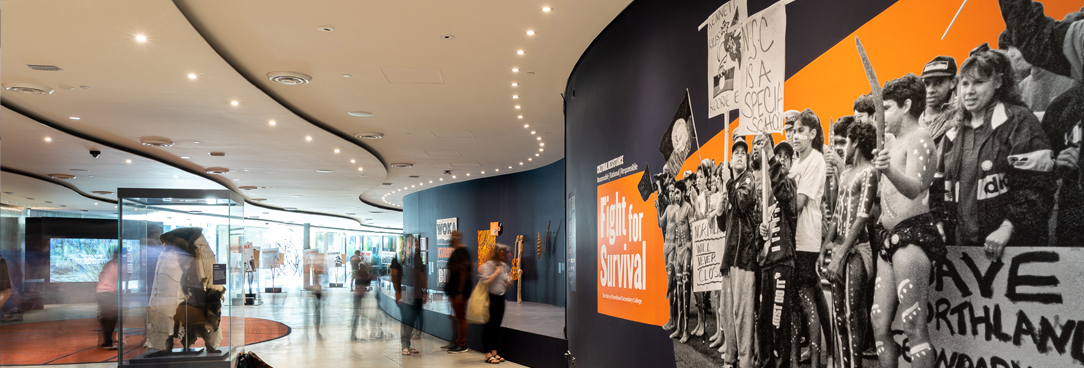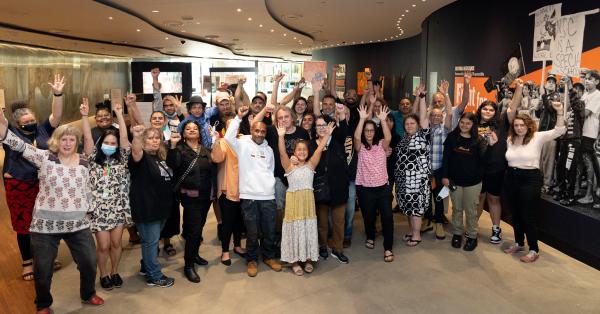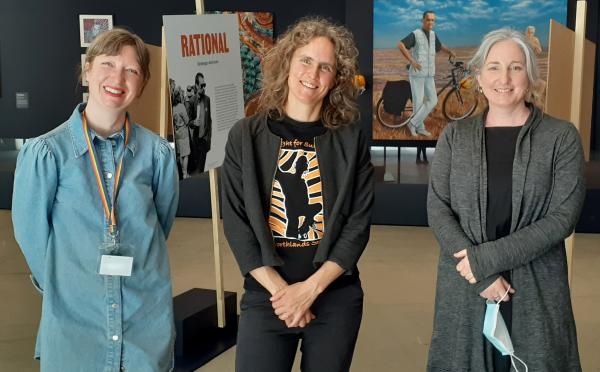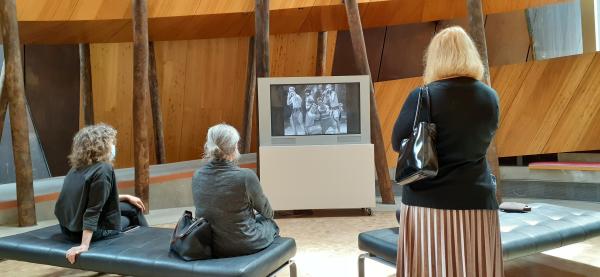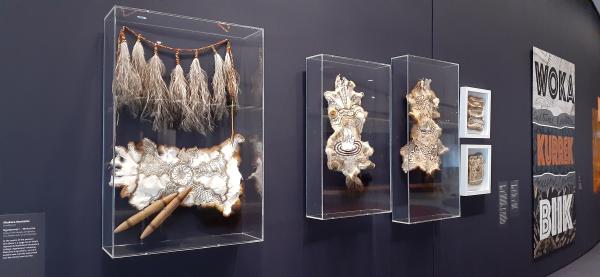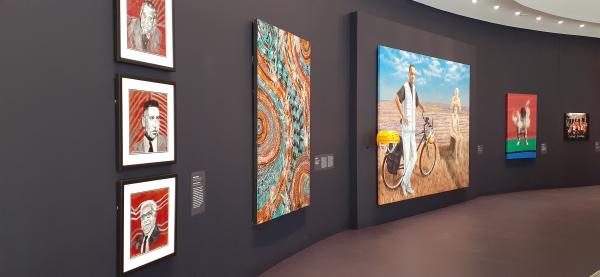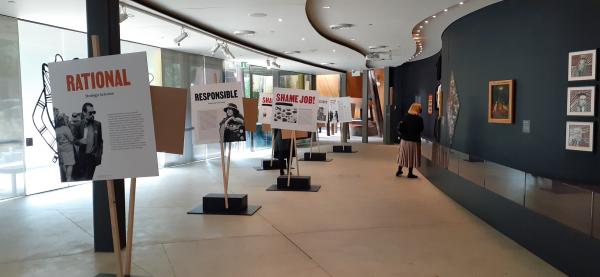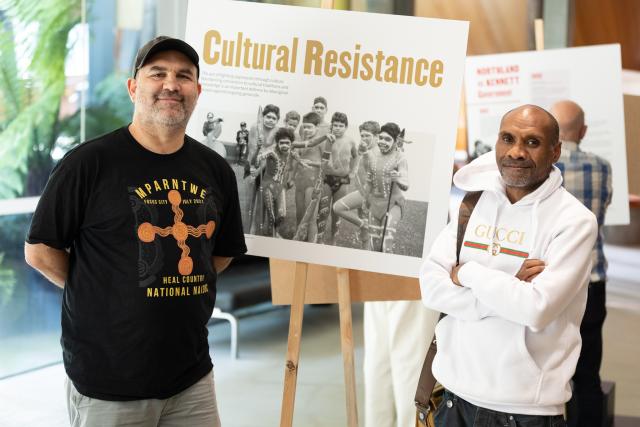
Author: Tara Oldfield
Senior Communications Advisor
As you walk through the ground floor of Melbourne Museum towards the First Peoples exhibition, you’re encircled by a stunning musical soundscape and you meet with Family cloak by Lee Griggs and family. These welcome and invite people to immerse themselves in the Northland story via engaging with the range of different forms of storytelling that intersect in different ways across the exhibition space.
Placards down the centre of the space share the story of Fight for survival, a temporary exhibition supported by PROV’s Local History Grants Program. It tells the story of *Northland Secondary College’s fight for survival when, in 1992, the Kennett Government tried to shut the school down. Stunning diamond-shaped collages of photos of the many activities that happened at Northland are scattered throughout displays that include original artworks, posters, political t-shirts and newspaper clippings.
The exhibition was curated by Lyn Thorpe, megan evans, Jill Morgan and Clare Land working as a collective.
In words by Lyn Thorpe with Alan Brown Sr on behalf of the Northlands Mob:
“Cultural resistance has the capacity to empower all people, to instil pride in our identities and our stories. It empowers us to know who we are, where we come from and to nurture our strengths and our aspirations. The Northlands story is a tribute to cultural resistance.”
The Northland story
As part of budget cuts across all parts of the Victorian Government, it was announced in November 1992 that hundreds of schools across the State would close, including Northland Secondary College. The decision to include Northland on the list of closures ignored the report of the Royal Commission into Aboriginal Deaths in Custody which, just one year earlier, had highlighted the school as a model way of working. The school’s approach to learning and valuing Aboriginal knowledge systems and culture made it a space free of racism and discrimination, with Koori students enrolling in increasing numbers and excelling at the school. And so the fight to save Northland began.
Victoria University historian Dr Clare Land describes the significance of this story and why it was so important for it to be displayed at the Melbourne Museum.
“This is a story where - as Professor Gary Foley has said - the actions of government had a dramatic and drastic impact on Aboriginal people in Melbourne. Aboriginal people collectively with non-Aboriginal people fought and stayed united throughout a long, difficult struggle and won… So it’s a story of community power and resilience and also a story of when governments get it really wrong and you have to fight for your rights.”
Archival materials
The Local History Grant Program funded the digital stories element of the exhibition which included interviews recorded for the project as well as archival footage.
“The archival footage was kept by members of the community who had fought for the school. Professor Gary Foley’s Aboriginal History Archive holds a very rich collection of materials from a lot of the campaigns he’s been a key part of. He has a lot of materials relating to the Northland campaign and he also knows who holds materials about the campaign in private hands. So a lot of people gave a lot of things to us, whether they be one newspaper clipping, or some photos or objects that they’d kept. A former student gave us two videos he’d done as part of a school assignment, an ex-teacher came up to me at one of our events and gave me one of the newspaper posters (on display) and one was from a former student who had it on his wall at home,” Clare explains.
Clare says the process of selection was a tough task with so much fantastic material to sort through.
“The thing we had to narrow down was photos because we had thousands of them, as well as hours of footage and a lot of newspaper clippings. The artwork (selection) was done through the curatorial process of talking to artists within the Northlands community and seeing who had work that they wanted to contribute or make specifically for the show.”
Another key part of the exhibition is the use of placards down the centre of the room used to explain the long and complicated campaign as a political reference. And one of the elements that is very special to Clare is a video work created by megan evans on behalf of the curatorial collective to acknowledge those who have passed on, presented at the top of the exhibition space. Being able to present three original songs by and about Northland community members in a soundscape was also a special part of the exhibition.
“The music is so rich and moving and gives so much atmosphere. The moving image video that you see when you come in was made especially for the show as a way of acknowledging and trying to hold a space for the families of those who’ve passed during the course of the Northland story from 1991 onwards and including right up until right before the show. So, people coming to see the exhibition need to be able to have that reflective opportunity with something that’s beautiful and ceremonial and links to the land,” says Clare.
Northlands musicians including Musical Director David Arden performed and recorded the three original songs as part of a Political Cabaret by the Northlands Collective Mob in May 2021. The exhibition soundscape and Cabaret also feature Rekindled systems by Allara Briggs Pattison and audio from a dance by Koori Youth Will Shake Spears.**
The campaign
Many actions went into the campaign for survival with a turning point being the creation of what was known as the ‘Northlands Rebel School.’ Even after technically closing, Rebel students and volunteer teachers led by Koori Educator Dedrie Baksh, continued to show up to the school where they continued classes throughout 1993. When they were eventually locked out, the Rebel students and teachers battled on, forming the Northlands Mobile Rebel School. Volunteer teachers picked Rebel students up from the locked-up school and drove to wherever they could find space for classes throughout 1994. They used the Koori Youth Will Shake Spears (‘Spears’) mini-bus, which was bought from the school with money earned by the Spears from paid dance performances.
An equal opportunity court case was also instrumental. Muthama Sinnappan and Bruce Foley’s central claim against the Kennett Government was that Northland was the only school where they, as Aboriginal students, experienced genuine access to quality education. In 1995, the Equal Opportunity Board and Supreme Court ordered the school be reopened.
Visit the exhibition
Fight for survival: Cultural resistance - Reasonable Rational Responsible - The story of Northland Secondary College is now showing at the Melbourne Museum until 24 July 2022. Visit the exhibition today, or attend the MV Lecture Fight for Survival: The grassroots story behind the Northlands exhibition on 11 June – book via this webpage to attend in person or online.
The Northlands Collective Mob is investigating ways to continue to share this important story beyond the life of the exhibition.
This exhibition was supported by a Local History Grant. Learn more about our grants and awards programs.
Thank you to Clare Land and the Northlands Collective for their assistance with this article.
*Northland Secondary College was known as Preston East Technical School until 1991 and is now the Northern College of the Arts and Technology.
**Koori Youth Will Shake Spears was founded at Northland Secondary College and was named by parent Robert Thorpe Snr. Many former students, younger generations & others still dance today with KYWSS & other groups.
Material in the Public Record Office Victoria archival collection contains words and descriptions that reflect attitudes and government policies at different times which may be insensitive and upsetting
Aboriginal and Torres Strait Islander Peoples should be aware the collection and website may contain images, voices and names of deceased persons.
PROV provides advice to researchers wishing to access, publish or re-use records about Aboriginal Peoples
